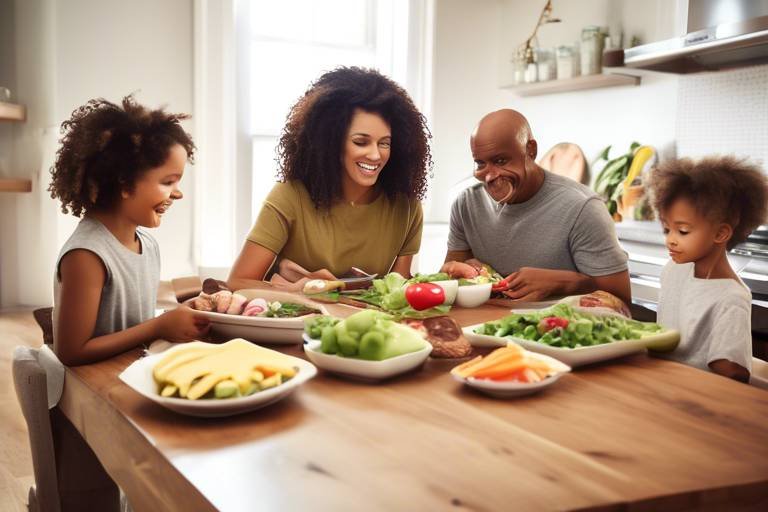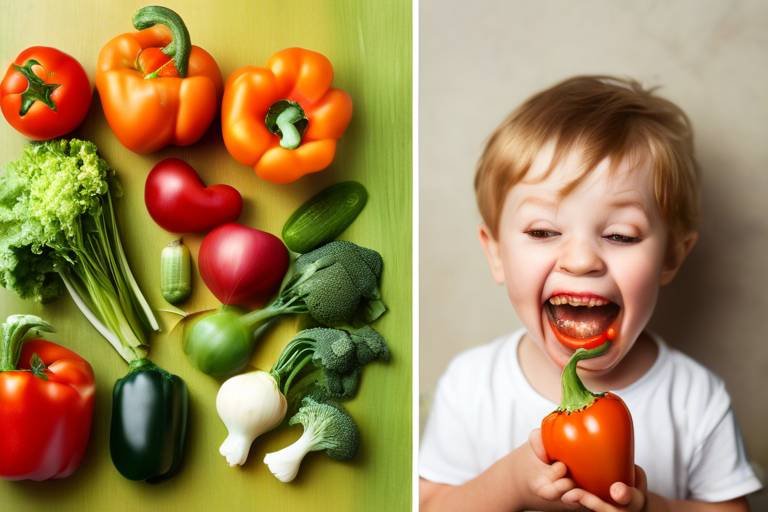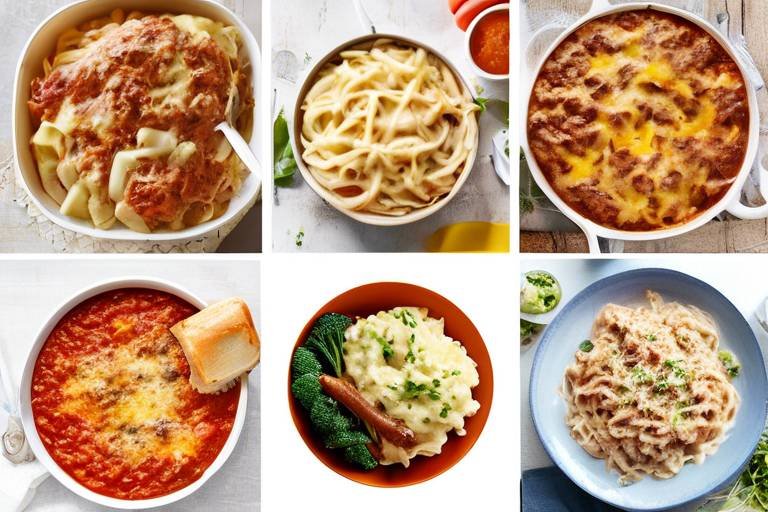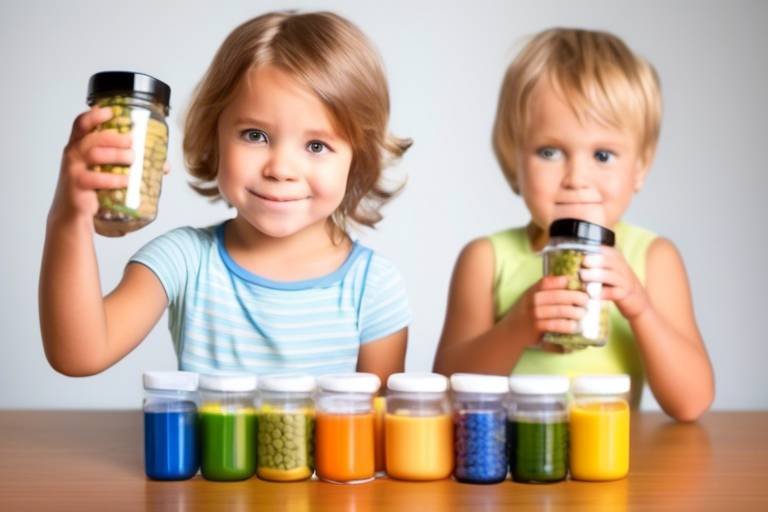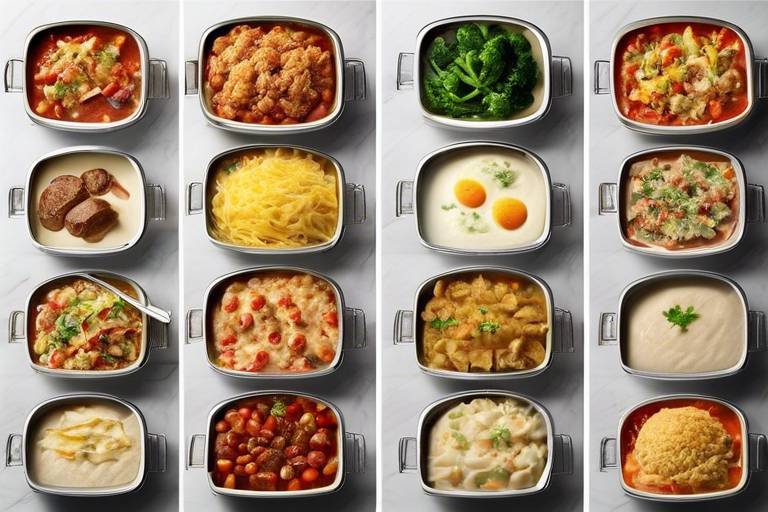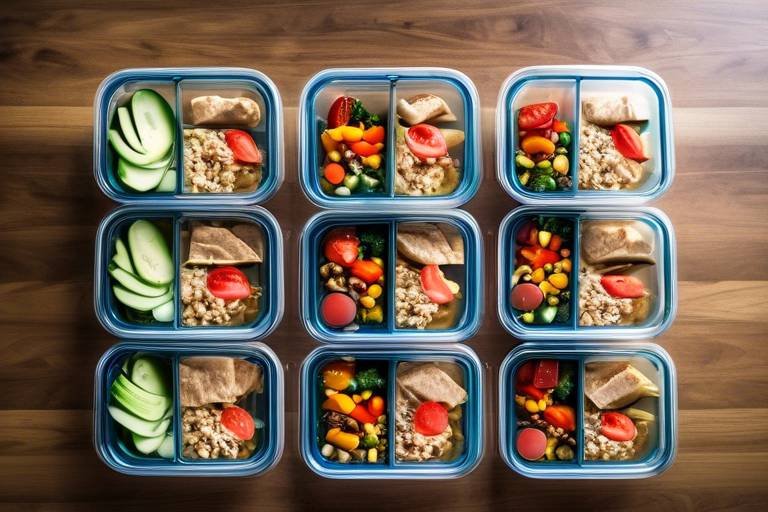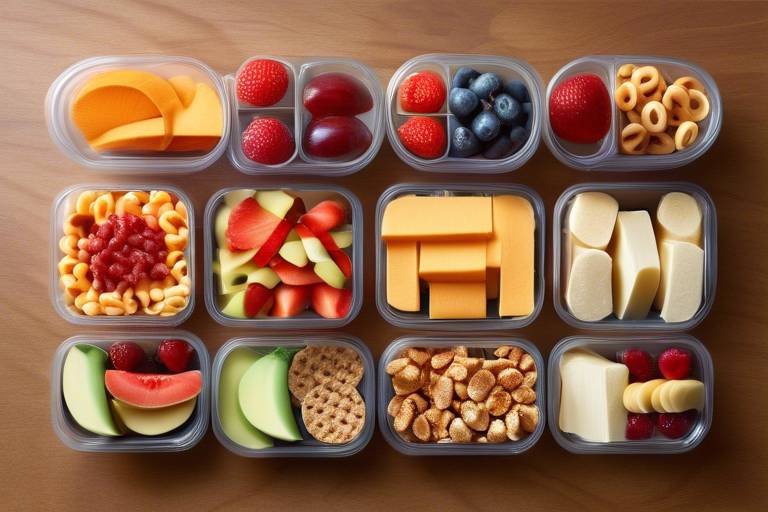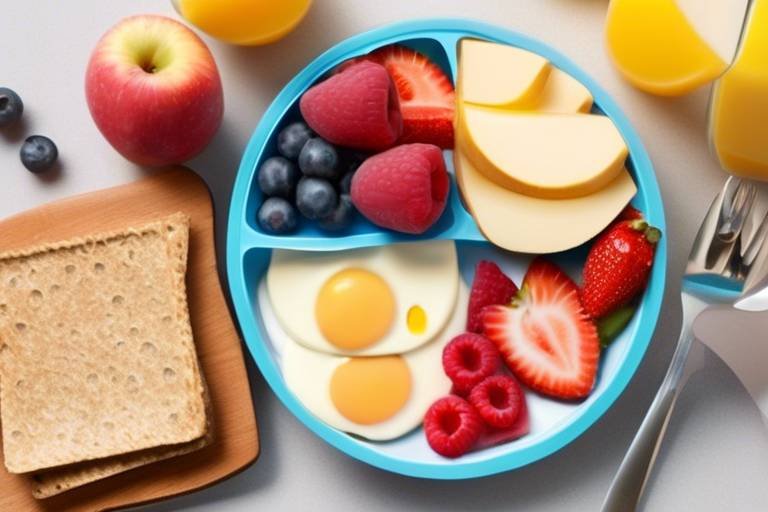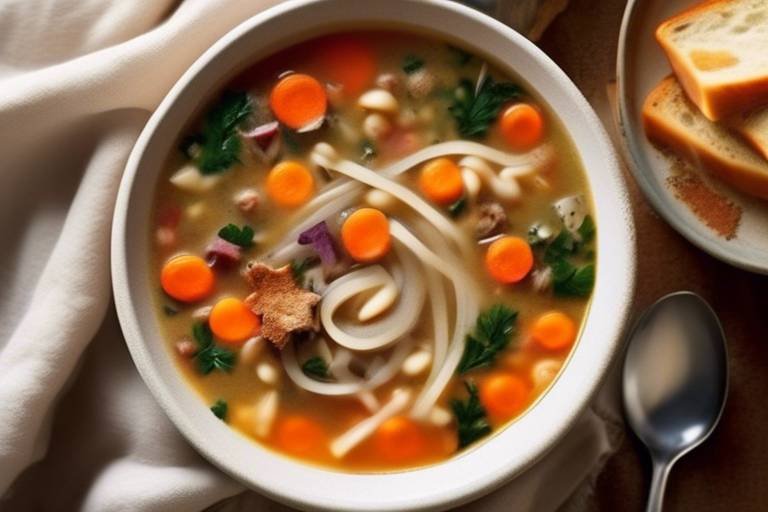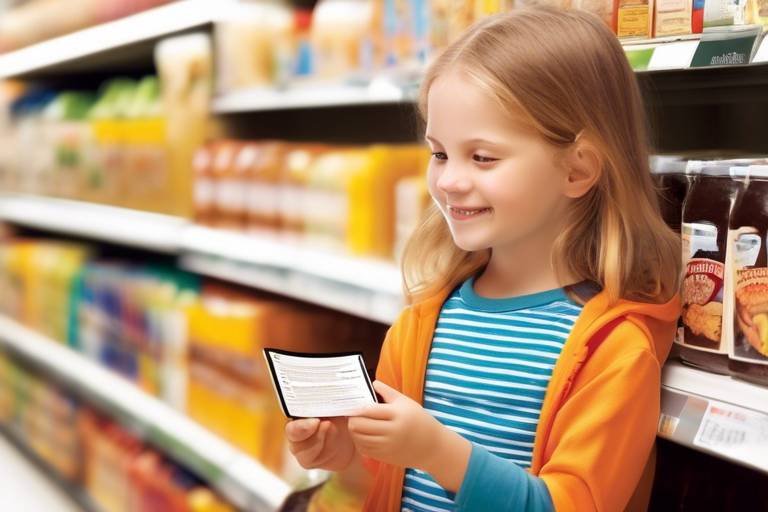Iron-Rich Foods Your Kids Should Eat
When it comes to our kids' health, we often focus on the big hitters—like vitamins and minerals. However, one nutrient that deserves a spotlight is iron. This essential mineral plays a crucial role in our children's growth and development, influencing everything from their physical health to cognitive abilities. So, why should you care about iron? Well, imagine your child’s body as a high-performance engine; without iron, it can’t run smoothly. Iron is vital for producing hemoglobin, the protein in red blood cells that carries oxygen throughout the body. Without enough iron, kids can feel fatigued, irritable, and struggle to concentrate in school.
In this article, we’ll dive deep into the world of iron-rich foods that your kids should be munching on. From juicy red meats to colorful vegetables, we’ll cover it all. Plus, we'll explore how you can make these foods appealing to picky eaters. Are you ready to become an iron-boosting superhero for your little ones? Let’s get started!
Before we jump into the delicious details, let’s take a moment to understand why iron is so important. Iron is not just another nutrient; it’s a key player in your child's development. It helps in the formation of hemoglobin, which is essential for transporting oxygen in the blood. Think of it as the delivery truck that ensures every cell in your child's body gets the oxygen it needs to function properly. Without sufficient iron, kids can experience iron deficiency anemia, which can lead to symptoms like fatigue, weakness, and impaired cognitive function. This means that a lack of iron can affect their ability to learn, play, and grow. It’s a big deal!
Now that we know why iron is essential, let's explore the best sources of this mineral. Iron comes in two forms: heme and non-heme. Heme iron is found in animal products and is more easily absorbed by the body, while non-heme iron is found in plant-based foods. It’s important to include both types in your child's diet to ensure they get enough iron.
When it comes to heme iron, think of it as the VIP section of iron sources. It’s more bioavailable, meaning your child's body can absorb it more efficiently. Here are some top sources:
Red meats like beef and lamb are fantastic sources of heme iron. They not only provide iron but are also rich in protein and other essential nutrients. Incorporating red meat into your meals can be as simple as grilling a steak or making a hearty beef stew. These meals can be both nutritious and comforting, making them a hit with kids!
Poultry, such as chicken and turkey, along with fish like salmon and tuna, are also excellent sources of heme iron. These proteins can be easily added to your child's favorite dishes. For example, try making chicken tacos or a fish sandwich. It’s all about making it fun and tasty!
Now, let’s talk about non-heme iron, which is found in plant-based foods. While it’s not as easily absorbed, it can still be a great addition to your child’s diet. Foods like spinach, lentils, and chickpeas are packed with iron. Pair them with vitamin C-rich foods like oranges or bell peppers to enhance absorption.
Understanding how to maximize iron absorption is vital for ensuring your child gets the most out of their meals. Did you know that certain foods can help or hinder iron absorption? For instance, vitamin C can significantly enhance iron absorption. So, if you’re serving a spinach salad, toss in some strawberries or oranges to boost the iron intake!
Combining iron-rich foods with vitamin C can make a huge difference. Here are some delicious pairings:
- Spinach salad with orange slices
- Lentil soup with a squeeze of lemon
- Beef stir-fry with bell peppers
On the flip side, some foods can inhibit iron absorption. For example, dairy products and calcium-rich foods can interfere with iron absorption, so it might be wise to serve these at different times. Additionally, tea and coffee contain tannins that can hinder iron absorption. Being mindful of these pairings can help your child maximize their iron intake.
Now that we’ve covered the importance of iron and where to find it, let’s get creative! Incorporating iron-rich foods into your kids' diets doesn’t have to be a chore. Think of fun and exciting ways to present these foods. You could make colorful smoothies loaded with spinach and fruits, or create a DIY taco night where kids can build their own iron-rich tacos with beans, chicken, and colorful veggies.
Q: How much iron do children need?
A: The recommended daily allowance varies by age, but generally, toddlers need about 7 mg, while older children require around 10-15 mg.
Q: Can I get enough iron from a vegetarian diet?
A: Absolutely! Many plant-based foods are rich in iron, especially when combined with vitamin C for better absorption.
Q: What are the symptoms of iron deficiency?
A: Symptoms can include fatigue, weakness, pale skin, and irritability. If you suspect your child is iron deficient, consult a healthcare provider.

Understanding Iron's Role in Child Development
Iron is not just another nutrient; it's a powerhouse that plays a vital role in the growth and development of children. Imagine iron as the fuel that powers a high-speed train; without it, the engine struggles to run smoothly. In children, iron is crucial for healthy brain development, as it helps in the production of hemoglobin, the protein in red blood cells responsible for transporting oxygen throughout the body. When kids have adequate iron levels, they are more likely to be energetic, focused, and ready to take on the world.
However, when children experience iron deficiency, the consequences can be serious. This deficiency can lead to a condition known as iron-deficiency anemia, which can manifest in various ways, including fatigue, weakness, and impaired cognitive function. Imagine trying to solve a puzzle with missing pieces; that’s what it feels like for a child who lacks sufficient iron. Their ability to concentrate in school can diminish, making learning a tough uphill battle. Studies show that children with low iron levels may struggle with attention span and memory retention, which can hinder their academic performance.
Furthermore, iron plays a role in the development of the immune system. It helps in the proliferation of immune cells, which are essential for fighting off infections. A child with low iron levels may find themselves catching colds and other illnesses more frequently. It's like trying to defend a castle with a weak army; without enough soldiers, the castle is vulnerable to attack. Therefore, ensuring that children receive enough iron is not just about preventing anemia; it's about setting them up for a lifetime of health and success.
To give you a clearer picture of the importance of iron, consider this table that highlights the key roles iron plays in child development:
| Function | Importance |
|---|---|
| Oxygen Transport | Essential for energy production and overall vitality. |
| Brain Development | Supports cognitive function and enhances learning abilities. |
| Immune Function | Helps in the development of immune cells to fight infections. |
| Growth and Development | Necessary for overall physical growth and development. |
In summary, iron is a critical nutrient that children need for their overall well-being. As parents and caregivers, it's essential to recognize the signs of iron deficiency and proactively include iron-rich foods in their diets. Remember, a well-nourished child is a happy and thriving child!

Top Sources of Iron for Kids
When it comes to ensuring our children get enough iron, it’s essential to understand that not all iron is created equal. There are two types of dietary iron: heme iron and non-heme iron. Heme iron, which is derived from animal sources, is more readily absorbed by the body. On the other hand, non-heme iron, found primarily in plant-based foods, is less easily absorbed but can still play a significant role in your child's diet. Knowing the right sources of iron can help you create a balanced meal plan that supports your child's growth and development.
Let’s dive into some of the top sources of iron that can easily fit into your kids' diets. Incorporating a mix of heme and non-heme iron options can ensure that they receive adequate amounts of this essential nutrient. Here’s a quick overview:
| Food Source | Type of Iron | Iron Content (mg per 100g) |
|---|---|---|
| Beef | Heme | 2.6 |
| Lamb | Heme | 1.8 |
| Chicken | Heme | 1.3 |
| Fish (Tuna) | Heme | 1.0 |
| Spinach | Non-Heme | 2.7 |
| Lentils | Non-Heme | 3.3 |
| Chickpeas | Non-Heme | 2.9 |
| Quinoa | Non-Heme | 1.5 |
As you can see from the table, red meats like beef and lamb are excellent sources of heme iron and should be included in your child's diet. Not only do they provide iron, but they also contain essential proteins and nutrients that are vital for growth. Poultry, such as chicken, is another great option, offering a milder flavor that many kids enjoy. Fish, particularly tuna, is not only rich in heme iron but also packed with omega-3 fatty acids, making it a double win for your child's health.
On the flip side, there are plenty of plant-based sources of non-heme iron that can be just as beneficial. For example, spinach, lentils, and chickpeas are fantastic options. They not only provide iron but also come with additional health benefits like fiber and vitamins. Quinoa is another excellent choice, offering a complete protein source that can be a staple in vegetarian diets.
When planning meals, it’s important to mix and match these sources to keep things interesting. For instance, you can create a delicious stir-fry with chicken and spinach or serve a hearty lentil soup alongside some grilled fish. The possibilities are endless, and the key is to keep it fun and engaging for your kids!
In summary, ensuring your kids consume a variety of iron-rich foods is crucial for their health and development. By understanding the different sources of heme and non-heme iron, you can craft a balanced diet that supports their nutritional needs. Remember, it’s not just about the iron content; it’s about making meals enjoyable and appealing to encourage your little ones to eat well.
- What are the symptoms of iron deficiency in kids? Symptoms can include fatigue, weakness, pale skin, and irritability.
- How can I enhance iron absorption in my child's diet? Pair iron-rich foods with vitamin C sources like oranges or bell peppers to boost absorption.
- Are there any foods I should avoid with iron-rich meals? Yes, foods high in calcium, like dairy, can inhibit iron absorption when eaten together.
- How much iron do children need daily? The recommended daily intake varies by age, but generally ranges from 7-10 mg for children.

Heme Iron Sources
When it comes to ensuring that our kids get enough iron in their diets, heme iron is a game changer. Found primarily in animal products, heme iron is absorbed by the body much more efficiently than its plant-based counterpart, non-heme iron. This means that incorporating heme iron sources into your child's meals can significantly boost their iron levels, supporting their growth and development in a way that is both effective and delicious.
One of the best sources of heme iron is red meat. Think of beef and lamb as the superheroes of iron-rich foods! Not only do they provide a hefty dose of heme iron, but they also come packed with essential nutrients like protein and zinc, which are vital for your child's overall health. You can easily incorporate red meat into your family meals by preparing tasty dishes such as beef stir-fry, lamb kebabs, or even a classic beef stew. These meals are not just nutritious; they can also be a delightful experience for your little ones, especially when paired with their favorite vegetables.
Next up on the heme iron list is poultry. Chicken and turkey are both excellent choices that can be prepared in a multitude of ways, making them appealing to kids. Whether it’s grilled chicken skewers, turkey meatballs, or a comforting chicken soup, there are endless possibilities to keep mealtime exciting. The mild flavors of poultry can easily be enhanced with various herbs and spices, allowing you to create dishes that are not only rich in iron but also bursting with flavor.
Don’t forget about fish! Certain types of fish, such as salmon and tuna, are not just tasty but also loaded with heme iron. They are fantastic options for introducing your kids to a variety of flavors and textures. You could whip up a delicious salmon burger or bake some tuna patties; both are fun ways to get your kids involved in the kitchen, making them more likely to eat what they help create.
To sum it all up, here’s a quick overview of some of the top heme iron sources for kids:
| Food Source | Iron Content (mg per 100g) |
|---|---|
| Beef | 2.7 |
| Lamb | 1.6 |
| Chicken | 1.0 |
| Turkey | 1.4 |
| Salmon | 0.8 |
| Tuna | 1.0 |
Incorporating these heme iron sources into your children’s diets doesn’t have to be a chore. With a little creativity and enthusiasm, you can transform mealtime into an adventure that not only nourishes their bodies but also excites their taste buds. Remember, a well-balanced diet rich in heme iron is essential for your child's growth, energy levels, and cognitive function. So let’s get cooking and make iron-rich meals that your kids will love!

Red Meat Options
When it comes to boosting your child's iron intake, red meat stands out as one of the most effective sources. Not only is it rich in heme iron, which is easily absorbed by the body, but it also provides essential nutrients that support overall growth and development. Think of red meat as a powerhouse packed with energy, helping your little ones conquer their day with vigor and vitality.
So, what types of red meat should you consider? Let's dive into some of the best options that can be both nutritious and delicious for your kids. Beef is at the top of the list. Whether it's a juicy steak, ground beef for burgers, or tender beef stew, there are countless ways to prepare it. Not only does beef provide iron, but it also contains important vitamins like B12, which is crucial for brain health.
Another fantastic option is lamb. Often overlooked, lamb is a flavorful alternative that packs a punch when it comes to iron content. You can serve it as lamb chops, in a hearty shepherd's pie, or even as kebabs. The versatility of red meat means you can get creative in the kitchen, making meals that are both appealing and nutritious.
It's essential to strike a balance, though. While red meat is beneficial, moderation is key. Aim to include red meat in your child's diet a few times a week, ensuring they also enjoy a variety of other iron-rich foods. Pairing red meat with vegetables or whole grains can create a well-rounded meal. For example, serve a beef stir-fry with colorful bell peppers and broccoli, or a lamb burger on a whole-grain bun topped with spinach. This not only enhances the meal's nutritional value but also makes it more visually appealing to your little diners.
In summary, red meat options like beef and lamb are excellent sources of iron that can easily be incorporated into your child's diet. By presenting these foods in fun and tasty ways, you can help your kids enjoy the benefits of iron while also developing healthy eating habits that last a lifetime. So, get creative, and let your culinary adventures begin!

Poultry and Fish
Poultry and fish are not just tasty options for dinner; they are also fantastic sources of heme iron, which is essential for your child's growth and development. When we talk about heme iron, we refer to the type of iron that comes from animal products, and guess what? The body absorbs it more efficiently than non-heme iron from plant sources. So, if you're looking to boost your child's iron intake, incorporating poultry and fish into their meals can be a game-changer!
Chicken, turkey, and various types of fish are not only rich in iron but also packed with other nutrients like protein and omega-3 fatty acids, which can help support brain health and overall well-being. For instance, a simple grilled chicken breast can provide your child with a significant amount of iron while being low in fat, making it an ideal choice for a healthy meal. Did you know that a 3-ounce serving of cooked chicken contains about 0.9 mg of iron? That's a great start!
When it comes to fish, options like salmon, tuna, and sardines not only deliver iron but also come with the added benefits of healthy fats that are crucial for brain development. One serving of salmon can offer around 0.5 mg of iron, plus it's deliciously versatile. You can bake it, grill it, or even toss it into a salad for a refreshing meal. The secret to making fish appealing to kids is often in the seasoning and preparation. Try making fish tacos or fish sticks with a crunchy coating that kids love!
To help you incorporate these iron-rich foods into your child's diet, here are some creative meal ideas:
- Chicken Stir-Fry: Toss chicken pieces with colorful vegetables and serve over brown rice for a nutritious meal.
- Fish Tacos: Use grilled fish, fresh toppings, and whole grain tortillas for a fun and healthy dinner.
- Turkey Meatballs: Mix ground turkey with herbs and spices, bake them, and serve with whole grain pasta.
By getting creative with how you serve poultry and fish, you're not just feeding your kids but also teaching them to enjoy a variety of flavors and textures. Plus, the more they enjoy the meal, the more likely they are to eat it! So, next time you're planning meals, remember that poultry and fish can be your allies in ensuring your child gets the iron they need to grow strong and healthy.
Q: How much iron do children need daily?
A: The daily iron requirement varies by age. For example, children aged 1-3 need about 7 mg, while those aged 4-8 need around 10 mg per day.
Q: Can vegetarian kids get enough iron?
A: Yes! Vegetarian kids can get enough iron from plant sources like lentils, beans, and fortified cereals, especially when paired with vitamin C-rich foods.
Q: How can I make sure my child absorbs iron effectively?
A: Pair iron-rich foods with vitamin C sources like oranges or bell peppers, and avoid serving dairy products at the same time as iron-rich meals, as calcium can inhibit absorption.

Non-Heme Iron Sources
When it comes to ensuring your kids get enough iron, non-heme iron is a fantastic option, especially for those following a vegetarian or vegan diet. Non-heme iron is primarily found in plant-based foods and is a bit trickier for the body to absorb compared to its counterpart, heme iron, which comes from animal sources. However, with the right food choices and combinations, you can significantly boost your child's iron intake!
Let’s dive into some delicious and nutritious non-heme iron sources that you can incorporate into your children’s meals. First up, we have legumes—think lentils, chickpeas, and beans. These powerhouses are not only rich in iron but also packed with protein and fiber, making them a wholesome addition to any meal. For example, a simple lentil soup can be both comforting and iron-rich, perfect for chilly evenings!
Next on the list are dark leafy greens like spinach, kale, and collard greens. These greens are not just great for iron; they also offer a plethora of vitamins and minerals that support overall health. You can sneak them into smoothies, salads, or even pasta dishes without your kids noticing! Imagine a vibrant spinach smoothie that’s both delicious and packed with nutrients—what a win-win!
Don’t forget about nuts and seeds, which are not only great snacks but also excellent sources of non-heme iron. Almonds, pumpkin seeds, and sunflower seeds can be easily added to yogurt, oatmeal, or even trail mixes for a crunchy, satisfying treat. Plus, they come with healthy fats that are essential for your child’s growth and development.
Whole grains are another fantastic source of non-heme iron. Foods like quinoa, brown rice, and oatmeal can be great staples in your pantry. Quinoa, for example, is a complete protein and can be used in salads, stir-fries, or even as a breakfast bowl topped with fruits. Just imagine a warm bowl of oatmeal topped with nuts and fruits—a delightful way to start the day!
To help you visualize the iron content in some of these non-heme sources, here’s a quick table:
| Food Item | Iron Content (mg per 100g) |
|---|---|
| Lentils | 3.3 |
| Spinach | 2.7 |
| Chickpeas | 2.9 |
| Quinoa | 1.5 |
| Pumpkin Seeds | 3.3 |
While these non-heme iron sources are beneficial, it’s important to remember that pairing them with foods high in vitamin C can enhance absorption significantly. For instance, adding a splash of lemon juice to your spinach salad or serving a side of strawberries with oatmeal can work wonders! On the flip side, certain foods and beverages can inhibit iron absorption, so it's wise to be mindful of what you serve alongside these iron-rich options.
Incorporating these non-heme iron sources into your child's diet can be both fun and rewarding. With a little creativity and planning, you can ensure your little ones are getting the iron they need for their growth and development. Who knew that making healthy choices could also be so tasty?
- What are some quick meals that include non-heme iron? Try a chickpea salad with lemon dressing, or a quinoa bowl topped with roasted vegetables.
- How can I enhance iron absorption in my child’s diet? Pair iron-rich foods with vitamin C sources like oranges, strawberries, or bell peppers.
- Are there any foods I should avoid with iron-rich meals? Yes, avoid serving calcium-rich foods or beverages like dairy and tea immediately with iron-rich meals as they can inhibit absorption.

Iron Absorption: Factors to Consider
When it comes to ensuring your child gets enough iron, it's not just about the foods they eat; it's also about how well their bodies can absorb that iron. Think of iron absorption as the magic key that unlocks the door to all the benefits of iron-rich foods. Without this key, even the healthiest meals might not provide the necessary nutrients your little ones need for their growth and development. So, what are the factors that can either boost or hinder this important process?
First up, let's talk about Vitamin C. This vibrant vitamin acts like a superhero for iron absorption! When your child consumes foods rich in iron alongside those high in Vitamin C, their bodies can absorb iron much more effectively. Imagine pairing a juicy orange or some strawberries with a delicious iron-rich meal; it’s like giving iron a turbo boost! For instance, serving a spinach salad topped with citrus dressing or adding bell peppers to a beef stir-fry can make a world of difference.
On the flip side, there are certain foods and drinks that can throw a wrench in the works. For example, calcium is known to compete with iron for absorption. So, while dairy products like milk and cheese are important for bone health, it’s best to keep them separate from iron-rich meals. Instead of serving a glass of milk with dinner, consider offering it as a snack at a different time of day. Similarly, tea and coffee contain tannins that can inhibit iron absorption, so it’s wise to avoid these beverages during meals.
Another factor to consider is the form of iron in the foods your child eats. Heme iron, found in animal products, is absorbed more efficiently than non-heme iron, which comes from plant sources. This means that if your child is primarily following a vegetarian or vegan diet, it’s crucial to be mindful of combining non-heme iron sources with Vitamin C-rich foods to enhance absorption. Foods like lentils, beans, and tofu can be great options, especially when paired with colorful fruits and vegetables.
In conclusion, understanding the factors that influence iron absorption can empower you to make informed choices for your child's diet. By combining the right foods and being aware of what to avoid, you can help ensure that your little ones not only eat iron-rich foods but also absorb the iron they need for optimal growth and health.
- What is the recommended daily intake of iron for children? The recommended daily intake varies by age and gender, but generally, children aged 1-3 need about 7 mg, while those aged 4-8 require about 10 mg of iron per day.
- Can too much iron be harmful to children? Yes, excessive iron intake can lead to iron overload, which can be harmful. It's important to consult with a healthcare provider before giving iron supplements.
- How can I tell if my child is iron deficient? Symptoms of iron deficiency can include fatigue, pale skin, and irritability. If you suspect deficiency, consult a pediatrician for proper testing and advice.

Vitamin C and Iron
When it comes to ensuring that your kids get enough iron, you might be surprised to learn that Vitamin C plays a crucial role in enhancing iron absorption. It’s like having a superhero sidekick for iron! While iron is essential for your child's growth and development, Vitamin C can help unlock its full potential in the body. This is especially important for children, as they often require higher amounts of iron for their rapidly growing bodies.
So, how does this work? Well, iron exists in two forms: heme and non-heme. Heme iron, found in animal products, is absorbed more easily than non-heme iron, which comes from plant sources. However, even non-heme iron can be effectively absorbed when paired with Vitamin C-rich foods. Think of it as a dynamic duo that can turn a simple meal into a powerhouse of nutrition!
To make this pairing work, consider incorporating foods high in Vitamin C alongside those rich in iron. For example, if you’re serving up a delicious plate of lentils (which are packed with non-heme iron), add a side of fresh oranges or a sprinkle of bell peppers to the dish. The Vitamin C from these foods will help your child’s body absorb the iron from the lentils much more effectively.
Here are some fantastic food pairings to consider:
- Spinach Salad with strawberries or citrus dressing
- Beef Tacos topped with fresh salsa made from tomatoes and peppers
- Chickpea Curry served with a side of mango chutney
- Oatmeal topped with kiwi or berries
By making these small adjustments in your meal planning, you can significantly increase the iron absorption for your little ones. Remember, it’s not just about eating iron-rich foods; it’s about creating a balanced meal that maximizes the benefits of those foods. So, next time you’re preparing a meal, think about how you can incorporate Vitamin C to supercharge your child’s iron intake!

Foods to Avoid with Iron
When it comes to ensuring that your kids get enough iron, it’s just as important to know what not to serve as it is to know what to include in their diets. Certain foods can actually hinder the absorption of iron, making it a bit of a minefield for parents trying to optimize their children's nutrition. For instance, foods high in calcium, like dairy products, can compete with iron for absorption in the intestines. So, while milk and cheese are great for bone health, they might not be the best companions for that iron-rich meal you’ve prepared.
Additionally, some types of grains and legumes contain phytates, which are compounds that can bind to iron and reduce its bioavailability. This means that even if you’re serving up a hearty portion of beans or whole grains, the iron they provide might not be fully utilized by your child's body. But don’t worry; it’s not about avoiding these foods completely. Instead, you can simply time their consumption wisely. For example, consider serving beans or whole grain bread at a different meal than the iron-rich foods.
Another group of foods to be cautious with includes those rich in tannins, such as tea and coffee. These beverages can significantly inhibit iron absorption, especially when consumed during or right after meals. So, if your little one loves to sip on a cup of herbal tea, it might be wise to serve it between meals rather than alongside dinner.
Here's a quick summary of foods to watch out for:
- Dairy Products: Milk, cheese, and yogurt can inhibit iron absorption.
- Foods High in Phytates: Whole grains and legumes may reduce iron bioavailability.
- Tannins: Tea and coffee can interfere with iron absorption.
Ultimately, striking a balance is key. You don’t have to eliminate these foods entirely; just be mindful of how they fit into your child’s overall diet. Pairing iron-rich meals with vitamin C sources, like oranges or bell peppers, can help enhance absorption and counteract the effects of these inhibitors. So, while you navigate the world of iron-rich foods, remember that it’s all about creating a harmonious balance that supports your child's health!
- What are the symptoms of iron deficiency in children? Symptoms can include fatigue, pale skin, and irritability. If you suspect your child is iron deficient, consult a healthcare provider.
- Can I get enough iron from a vegetarian diet? Absolutely! Many plant-based foods are rich in iron. Just be sure to pair them with vitamin C to enhance absorption.
- How can I make iron-rich foods more appealing to my kids? Try incorporating fun recipes, colorful presentations, or even involving them in the cooking process to spark their interest!

Creative Ways to Include Iron in Meals
Getting kids to eat their veggies and protein can sometimes feel like pulling teeth, right? But fear not! There are creative ways to sneak in those iron-rich foods that not only boost their health but also make mealtime fun and engaging. Think of it as a culinary adventure, where you’re the captain steering your ship through the sea of nutrition!
One fantastic way to incorporate iron into meals is by creating colorful, vibrant dishes that appeal to your child’s eyes and taste buds. For instance, why not whip up a rainbow stir-fry? Load up on leafy greens like spinach and kale, toss in some bell peppers, and add a protein source like chicken or tofu. The colors will attract your little ones, and the variety of textures will keep them excited about eating. Plus, you can explain how each color represents a different nutrient!
Another fun idea is to make iron-packed smoothies. Blend together ingredients such as spinach, banana, and fortified cereals. You can even add a splash of orange juice for a vitamin C boost, which helps with iron absorption. Serve it in a cool cup with a funky straw, and watch your kids slurp it up like it’s a treat! You can also freeze these smoothies in popsicle molds for a refreshing snack on a hot day.
Now, let’s talk about the power of creative presentations. Kids are often more inclined to eat foods that look fun. For example, use cookie cutters to shape sandwiches made with whole grain bread, turkey, and cheese into stars or hearts. Pair these with a side of iron-rich hummus and veggie sticks. The playful shapes will make your children more curious about what’s on their plate. You could even host a “make your own sandwich” night where they can choose their favorite fillings!
Don’t forget about the magic of dips. Kids love to dip their food! Create a fun dipping station with iron-rich options like chickpea salad, guacamole, or a yogurt-based dip. Serve with whole-grain pita chips, carrots, and cucumber slices. This not only makes eating interactive but also encourages them to try different flavors. You can even turn it into a game by having them guess the ingredients in the dips!
Lastly, consider involving your children in the cooking process. Kids are more likely to eat what they’ve helped prepare. Set up a mini cooking class at home where they can assist in making iron-rich meals. Whether it’s mixing a quinoa salad, rolling up some veggie sushi, or stirring a pot of chili, they’ll feel proud of their creations. Plus, you can sneak in educational moments by talking about the benefits of each ingredient.
In summary, making iron-rich foods appealing to kids doesn’t have to be a chore. With a little creativity and fun, you can turn mealtime into an enjoyable experience that nourishes their bodies and minds. So, grab your apron and let the culinary creativity begin!
- What are some quick iron-rich snacks for kids?
Some quick options include iron-fortified cereals, dried fruits like apricots and raisins, and nut butter on whole-grain crackers. - How can I tell if my child is iron deficient?
Look for signs such as fatigue, pale skin, or frequent infections. It's best to consult a pediatrician for proper testing. - Can I enhance iron absorption with other foods?
Absolutely! Pairing iron-rich foods with vitamin C sources like citrus fruits, strawberries, or bell peppers can significantly boost absorption.
Frequently Asked Questions
- Why is iron important for my child's development?
Iron plays a critical role in your child's growth, brain development, and overall health. It helps in the formation of hemoglobin, which carries oxygen in the blood. Without adequate iron, children may experience fatigue, developmental delays, and cognitive impairments.
- What are the best sources of heme iron for kids?
Heme iron, which is more easily absorbed by the body, can be found in animal products. The best sources include red meats like beef and lamb, as well as poultry and fish. Incorporating these foods into your child's diet can significantly boost their iron levels.
- Can vegetarian kids get enough iron?
Absolutely! Vegetarian kids can obtain iron from non-heme sources such as beans, lentils, tofu, spinach, and fortified cereals. Pairing these foods with vitamin C-rich options like oranges or bell peppers can enhance iron absorption, making it easier for them to meet their nutritional needs.
- How can I improve my child's iron absorption?
To boost iron absorption, include vitamin C-rich foods in meals. Foods like strawberries, kiwi, and broccoli can help. Additionally, try to limit foods high in calcium or tannins, such as dairy products and certain teas, during iron-rich meals, as they can inhibit absorption.
- What are some creative ways to include iron-rich foods in meals?
Get creative by making fun meals that kids will love! Try iron-rich smoothies with spinach and fruit, or create colorful stir-fries with tofu and a variety of veggies. You can also bake iron-rich muffins using whole grains and add nuts or seeds for an extra boost!
- How can I tell if my child is iron deficient?
Signs of iron deficiency can include fatigue, pale skin, irritability, and poor concentration. If you suspect your child may be iron deficient, it's essential to consult with a healthcare provider for proper testing and guidance.





